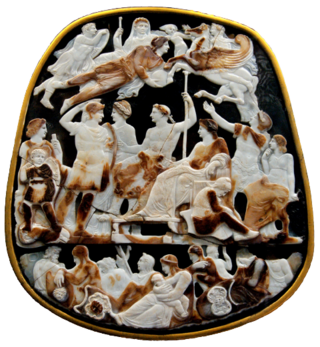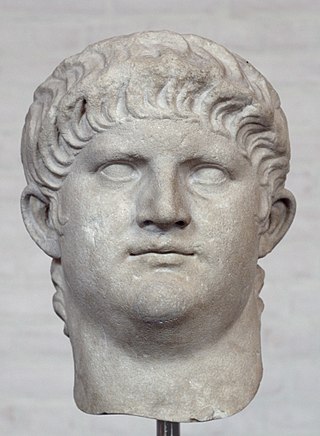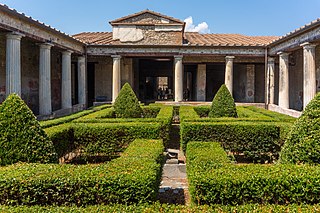Related Research Articles

Galba was Roman emperor, ruling from AD 68 to 69. He was the first emperor in the Year of the Four Emperors and assumed the throne following Emperor Nero's suicide.

The Julio-Claudian dynasty comprised the first five Roman emperors: Augustus, Tiberius, Caligula, Claudius, and Nero.

Nero Claudius Caesar Augustus Germanicus was Roman emperor and the final emperor of the Julio-Claudian dynasty, reigning from AD 54 until his death in AD 68.

The 30s decade ran from January 1, AD 30, to December 31, AD 39.

The 60s decade ran from January 1, AD 60, to December 31, AD 69.
AD 35 (XXXV) was a common year starting on Saturday of the Julian calendar. At the time, it was known as the Year of the Consulship of Gallus and Nonianus. The denomination AD 35 for this year has been used since the early medieval period, when the Anno Domini calendar era became the prevalent method in Europe for naming years.
Ofonius Tigellinus (c. 10 – 69) was a prefect of the Roman imperial bodyguard, known as the Praetorian Guard, from 62 until 68, during the reign of emperor Nero. Tigellinus gained imperial favour through his acquaintance with Nero's mother Agrippina the Younger, and was appointed prefect upon the death of his predecessor Sextus Afranius Burrus, a position Tigellinus held first with Faenius Rufus and then Nymphidius Sabinus.

The gens Claudia, sometimes written Clodia, was one of the most prominent patrician houses at ancient Rome. The gens traced its origin to the earliest days of the Roman Republic. The first of the Claudii to obtain the consulship was Appius Claudius Sabinus Regillensis, in 495 BC, and from that time its members frequently held the highest offices of the state, both under the Republic and in imperial times.
The gens Sulpicia was one of the most ancient patrician families at ancient Rome, and produced a succession of distinguished men, from the foundation of the Republic to the imperial period. The first member of the gens who obtained the consulship was Servius Sulpicius Camerinus Cornutus, in 500 BC, only nine years after the expulsion of the Tarquins, and the last of the name who appears on the consular list was Sextus Sulpicius Tertullus in AD 158. Although originally patrician, the family also possessed plebeian members, some of whom may have been descended from freedmen of the gens.

Poppaea Sabina, also known as Ollia, was a Roman empress as the second wife of the Emperor Nero. She had also been wife to the future emperor Otho. The historians of antiquity describe her as a beautiful woman who used intrigues to become empress.

Achaia, sometimes spelled Achaea, was a province of the Roman Empire, consisting of the Peloponnese, Attica, Boeotia, Euboea, the Cyclades and parts of Phthiotis, Aetolia-Acarnania and Phocis. In the north, it bordered on the provinces of Epirus vetus and Macedonia. The region was annexed by the Roman Republic in 146 BC following the sack of Corinth by the Roman general Lucius Mummius, who was awarded the surname "Achaicus". Initially part of the Roman province of Macedonia, it was made into a separate province by Augustus.

Claudia Octavia was a Roman empress. She was the daughter of the Emperor Claudius and Valeria Messalina. After her mother's death and father's remarriage to her cousin Agrippina the Younger, she became the stepsister of the future Emperor Nero. She also became his wife, in a marriage between the two which was arranged by Agrippina.

The House of Menander is one of the richest and most magnificent houses in ancient Pompeii in terms of architecture, decoration and contents, and covers a large area of about 1,800 square metres (19,000 sq ft) occupying most of its insula. Its quality means the owner must have been an aristocrat involved in politics, with great taste for art.
Quintus Sulpicius Camerinus Peticus was a Roman senator during the reign of Nero.
Quintus Sulpicius Camerinus was a Roman senator and poet, who served as Consul in AD 9 as the colleague of Gaius Poppaeus Sabinus. He is particularly remembered for his poem about the capture of Troy by Hercules. Ovid wrote about him in Ponto memoravit. He is a member of the gens Sulpicia.
The gens Poppaea was a minor plebeian family at ancient Rome. Members of this gens first appear under the early Empire, when two brothers served as consuls in AD 9. The Roman empress Poppaea Sabina was a descendant of this family, but few others achieved any prominence in the Roman state. A number of Poppaei are known from inscriptions. The name is sometimes confused with that of Pompeia.
Quintus Poppaeus Q. f. Q. n. Secundus was consul suffectus in AD 9, and one of the authors of the lex Papia Poppaea.
Camerinus Antistius Vetus was a Roman senator, who was active during the reign of Claudius. He was suffect consul in the for a few days in the month of March AD 46 as the colleague of Marcus Junius Silanus; Quintus Sulpicius Camerinus is recorded as consul for the rest of the nundinium. Camerinus is also known to have been urban praetor in the year 43. He is known entirely from inscriptions.
Poppaea Sabina the Elder was an aristocratic woman who lived during the Principate. During her lifetime she was famed for her beauty, but as Ronald Syme writes, her "fame and follies have been all but extinguished by her homonymous daughter", Poppaea Sabina the Younger. She met her end as a victim of the empress Valeria Messalina, wife of Claudius.
References
- ↑ Attilio Degrassi, I fasti consolari dell'Impero Romano dal 30 avanti Cristo al 613 dopo Cristo (Rome, 1952), p. 7
- ↑ Diana Bowder (1 December 1980). Who was who in the Roman world, 753 BC-AD 476 . Ithaca: Cornell University Press. p. 176. ISBN 978-0-8014-1358-2.
- ↑ Anthony Everitt (2006). The First Emperor: Caesar Augustus and the Triumph of Rome. London: Murray. p. 254. ISBN 978-0-7195-5494-0.
- ↑ Thomas Elliott (2004). Epigraphic Evidence for Boundary Disputes in the Roman Empire (PhD). University of North Carolina. pp. 65–67.
- ↑ Diana Bowder (1984). Who was who in the Roman world. New York: Washington Square Press. p. 435.
- ↑ J. S. Wacher (2002). The Roman world. Vol. 1. New York: Routledge Taylor & Francis. p. 101. ISBN 978-0-415-26315-3.
- ↑ Simon Hornblower; Antony Spawforth (2000). Who's who in the classical world. Oxford: Oxford University Press. p. 319. ISBN 978-0-19-280107-4.
- ↑ Jurgen Malitz (2008). Nero. Malden: John Wiley & Sons. p. 30. ISBN 978-1-4051-4474-2.